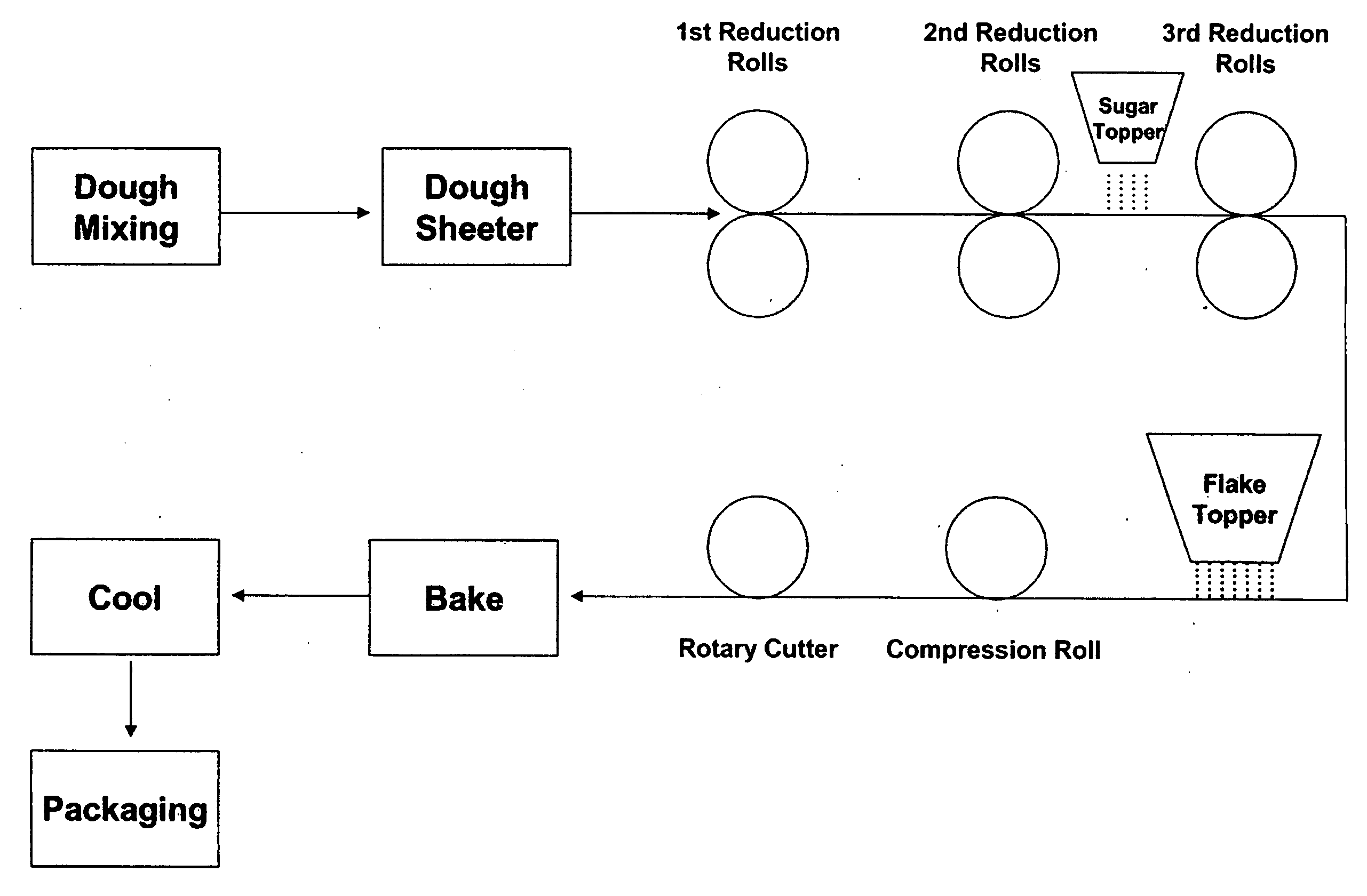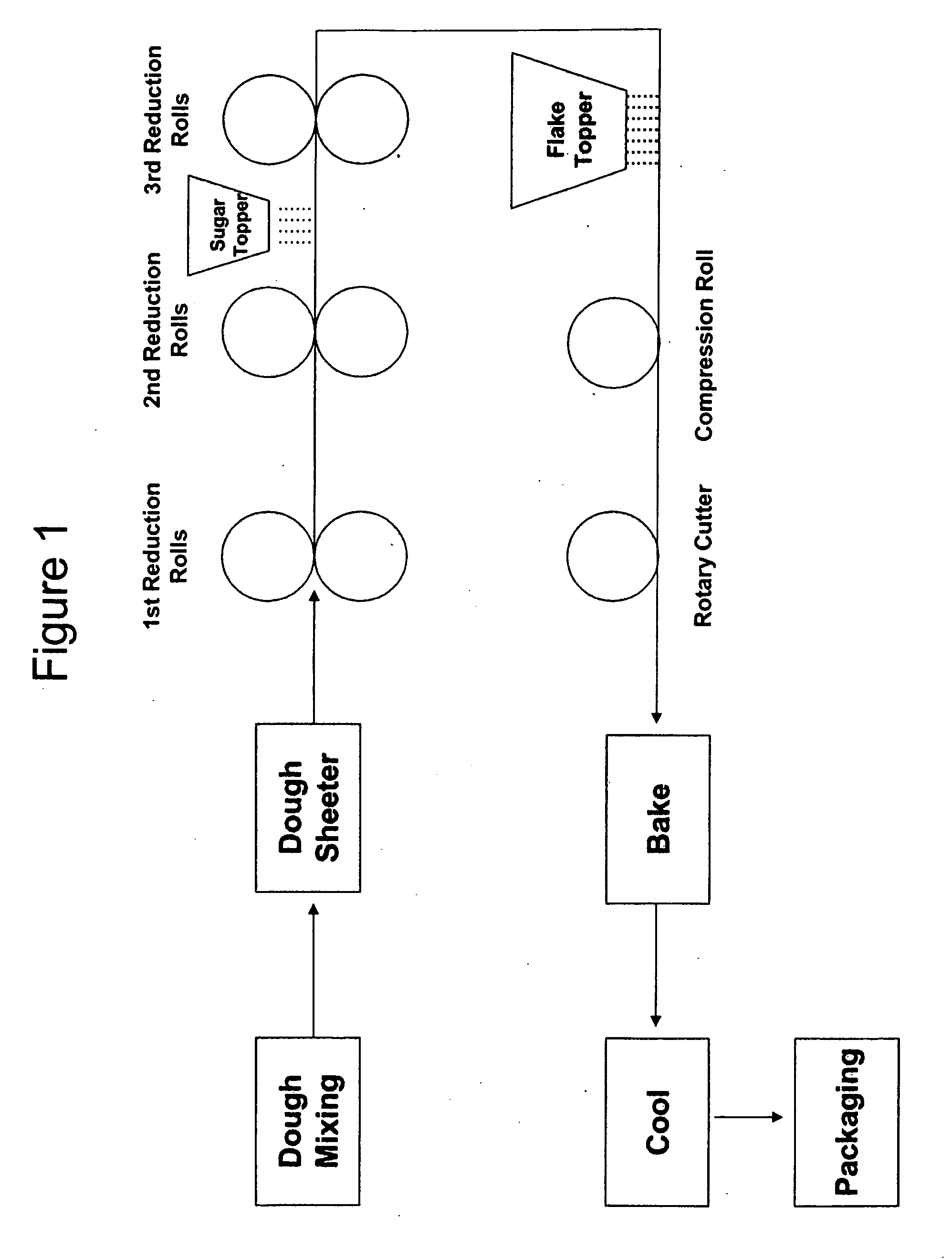Processes for adhering food particulates to dough and related food items
a technology of food particulates and processing equipment, applied in the field of processing equipment for adhering food particulates to dough and related food items, can solve the problems of reducing the maximum size of particulates, reducing the maximum size of parts, and reducing was
- Summary
- Abstract
- Description
- Claims
- Application Information
AI Technical Summary
Benefits of technology
Problems solved by technology
Method used
Image
Examples
example 1
Preparation of a Dill and Rye Cracker with Caraway Seeds
[0052]
CRACKER DOUGH INGREDIENTSMEASUREMENTunbleached white flour2cupswhole wheat flour.5cuprye flour.5cupsalt1teaspoonunsalted butter, softened.5cupwarm water.5cupfinely snipped dill leaves3tablespoonssalt1teaspoondill seed1teaspoon
[0053]The flours and one teaspoon salt are mixed in a large bowl. The softened butter is processed in a food processor with the flour and salt mixture to make a fine meal. The warm water and dill leaves are mixed into the flour, salt and butter mixture. The dough is kneaded for five minutes, then rolled on a lightly floured surface into a ⅛ inch rectangle. The top of the cracker is sprinkled somewhat evenly with ⅓ cup crystalline maltose and sprinkled somewhat evenly with ¼ cup caraway seeds. The cracker is baked in a 450° F. oven for 10-12 minutes or until the crystals liquefy. The cracker is cooled flat until the crystals solidify.
example 2
Preparation of a Graham Cracker with Frosted Wheat Flakes on the Surface
[0054]
CRACKER DOUGH INGREDIENTSMEASUREMENToil¼cuphoney⅓cupmolasses2tablespoonsvanilla1teaspoonwhole wheat flour2½cupbaking powder1teaspoonsalt¼teaspooncinnamon1teaspoonmilk¼ to ½cup
[0055]Oil, honey, molasses, milk and vanilla are mixed in a first bowl to form a liquid mix. Flour, baking powder, salt and cinnamon are combined in a second bowl to form a dry mix. The dry mix is added to the liquid mix. The combination is mixed well to form a dough. The dough is divided in half and such half is rolled directly onto a baking sheet. A top surface of the dough is sprinkled somewhat evenly with ¼ cup brown sugar and then sprinkled somewhat evenly with ½ cup crushed wheat flakes. The topped cracker dough is then baked at 500° F. for approximately 10 minutes and subsequently cooled.
example 3
Preparation of a Butter Cracker with Crushed Corn Flakes® on the Surface
[0056]
CRACKER DOUGH INGREDIENTSMEASUREMENTflour3cupsunsalted butter¾cupsugar3tablespoonssalt1½teaspoonsmilk1cup
[0057]The first four ingredients are crumbled together. Enough milk is then added and stirred to make a stiff dough. The dough is rolled as thin as possible. The dough is then sprinkled somewhat evenly with ⅔ cups crushed Corn Flakes® that have been tossed with ⅓ powdered lactose. The dough is then cut into oval shapes and pricked with a fork. The cracker is baked at 475° F. for approximately 10 minutes and subsequently cooled.
PUM
 Login to View More
Login to View More Abstract
Description
Claims
Application Information
 Login to View More
Login to View More - R&D
- Intellectual Property
- Life Sciences
- Materials
- Tech Scout
- Unparalleled Data Quality
- Higher Quality Content
- 60% Fewer Hallucinations
Browse by: Latest US Patents, China's latest patents, Technical Efficacy Thesaurus, Application Domain, Technology Topic, Popular Technical Reports.
© 2025 PatSnap. All rights reserved.Legal|Privacy policy|Modern Slavery Act Transparency Statement|Sitemap|About US| Contact US: help@patsnap.com


